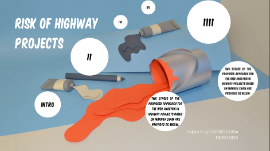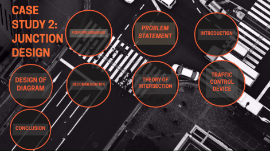HighWay
Transcript: RISK of HIGHWAY PROJECTS Yakup KIlıç/ 20180301094 13/05/2020 analyzing risks in highway projects Intro IE-405 Project Presentation What IS Risk for Highway Project What Are these risks Risks within highway projects can be defined as an uncertain event that has a positive or negative effect on the objectives (e.g., time, cost, scope, and quality) The processes involve planning, identification, analysis, response planning, monitoring and control on highway projects. 11 Appropriate measures can be taken in the project risk management in order to minimize negative effects on the projects objectives (e.g., schedule, cost, scope and quality); maximize chances to improve the objectives by considering the low cost, short schedules, enhanced scope and high quality; and minimize management by crisis. 1 Stochastic process (e.g., Markov chain approach) is a powerful approach introduced for analyzing the time-dependent behavior of numerous dynamic systems. 11 A highway project often is divided into three major phases: (1) planning; (2) engineering; and (3) construction. Potential risks change continuously in the life-cycle of highway projects. Therefore, highway project risks may be modeled in a stochastic environment (e.g., random variables or in a dynamic framework, a stochastic process) 111 Furthermore, because the progress of highway projects mainly depends on the project situations, the potential risks within highway projects have the characteristics of the stochastic process. It can be modeled by Markov chains; Two stages of the proposed approach for the risk analysis in highway projects based on Markov chain are provided as below. Risks of highway projects are collected by applying historical information, lessons learned and NGT technique in order to provide potential risk break down structure (PRBS). Numerous approaches have been suggested in the literature for classifying risks . Potential risks of the highway projects are grouped in adhere to project WBS in order to consider potential risks in different levels of the project and scope of work. Project potential risk data gathering We pre-define the levels of the potential risk denoted by PRL1, PRL2, …, PRLi, …, PRLj. Two stages of the proposed approach for the risk analysis in highway projects based on Markov chain are provided as below. Project Potential Risk Analysis In planning phase of a highway project, experts or decision makers with the total number as k are gathered to analysis potential risks of the projects. 1 If there are Ki experts who determine the risk level as PRLi, the probability of this project exposed to risk level PRLi can be computed as Then, we get the initial distribution of potential risk probabilities as : 11 "Sn" is the risk distribution after n-step transition. Namely, the risk distribution at each risk level remains constant after a long enough time. This distribution can be solved through Equation: 1111 Application example is presented for risk analysis of highway project . The purposes of work are as follows: Identifying the potential risks for highway projects. Designing a project risk analysis model for the potential risks by using Markov chains. Application Pre-stage: Establishing a risk management team is the main predecessor of risk analysis process with the highway project. The main goal of the team is to identify and analyze potential risks of the highway project to find their priorities for further measures. Size, budget, location, available resources and unique aspects of the highway project are some factors that influence the selection of a risk management team for the highway project. Stage one: Potential risk data gathering The potential risk breakdown structure (PRBS) based on the highway project WBS is then extended to summarize the different categories of risks. Project potential risks are divided into four groups, engineering, procurement, construction, and management. The PRBS is depicted in Table 1. Stage two: Potential risk data gathering 25 experts with high qualification regarding this subject are selected to form a risk analysis group for undertaking the risk assessment by using the proposed stochastic approach. Levels are (i.e., Very Low (VL), Low (L), Medium (M), High (H), Very High (VH)) in Table 2. The initial potential risk distribution can be derived as title one-step transition probability matrix is then, the severity of the risks has been decreased during the life-cycle of the highway project, particularly for the risks in medium, high, and very high levels. the risk response planning brought the overall risk of the project down to an acceptable level and therefore, risk management has been effective way for managing these projects. 1111 Conclusions The main aim was make understand the different risks in highway projects and to propose a stochastic model of analysis in an uncertain environment. Thus, the stochastic process approach based on Markov chain was presented. The computational results have

















